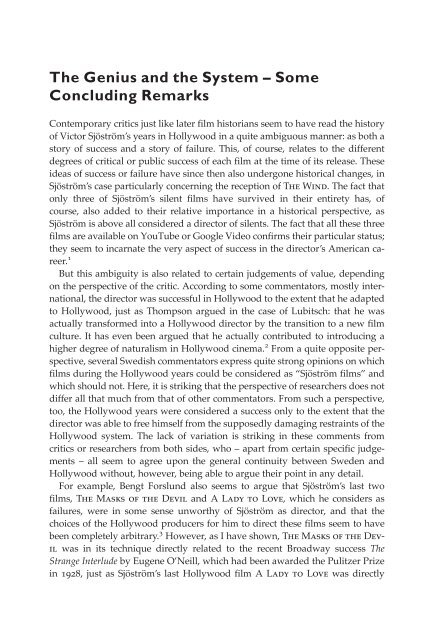FILM FILM - University of Macau Library
FILM FILM - University of Macau Library
FILM FILM - University of Macau Library
You also want an ePaper? Increase the reach of your titles
YUMPU automatically turns print PDFs into web optimized ePapers that Google loves.
TheGeniusandtheSystem– Some<br />
Concluding Remarks<br />
Contemporary critics just like later film historians seem to have read the history<br />
<strong>of</strong> Victor Sjöström’s years in Hollywood in a quite ambiguous manner: as both a<br />
story <strong>of</strong> success and a story <strong>of</strong> failure. This, <strong>of</strong> course, relates to the different<br />
degrees <strong>of</strong> critical or public success <strong>of</strong> each film at the time <strong>of</strong> its release. These<br />
ideas <strong>of</strong> success or failure have since then also undergone historical changes, in<br />
Sjöström’s case particularly concerning the reception <strong>of</strong> The Wind. The fact that<br />
only three <strong>of</strong> Sjöström’s silent films have survived in their entirety has, <strong>of</strong><br />
course, also added to their relative importance in a historical perspective, as<br />
Sjöström is above all considered a director <strong>of</strong> silents. The fact that all these three<br />
films are available on YouTube or Google Video confirms their particular status;<br />
they seem to incarnate the very aspect <strong>of</strong> success in the director’s American career.<br />
1<br />
But this ambiguity is also related to certain judgements <strong>of</strong> value, depending<br />
on the perspective <strong>of</strong> the critic. According to some commentators, mostly international,<br />
the director was successful in Hollywood to the extent that he adapted<br />
to Hollywood, just as Thompson argued in the case <strong>of</strong> Lubitsch: that he was<br />
actually transformed into a Hollywood director by the transition to a new film<br />
culture. It has even been argued that he actually contributed to introducing a<br />
higher degree <strong>of</strong> naturalism in Hollywood cinema. 2 From a quite opposite perspective,<br />
several Swedish commentators express quite strong opinions on which<br />
films during the Hollywood years could be considered as “Sjöström films” and<br />
which should not. Here, it is striking that the perspective <strong>of</strong> researchers does not<br />
differ all that much from that <strong>of</strong> other commentators. From such a perspective,<br />
too, the Hollywood years were considered a success only to the extent that the<br />
director was able to free himself from the supposedly damaging restraints <strong>of</strong> the<br />
Hollywood system. The lack <strong>of</strong> variation is striking in these comments from<br />
critics or researchers from both sides, who – apart from certain specific judgements<br />
– all seem to agree upon the general continuity between Sweden and<br />
Hollywood without, however, being able to argue their point in any detail.<br />
For example, Bengt Forslund also seems to argue that Sjöström’s last two<br />
films, The Masks <strong>of</strong> the Devil and A Lady to Love, which he considers as<br />
failures, were in some sense unworthy <strong>of</strong> Sjöström as director, and that the<br />
choices <strong>of</strong> the Hollywood producers for him to direct these films seem to have<br />
been completely arbitrary. 3 However, as I have shown, The Masks <strong>of</strong> the Devil<br />
was in its technique directly related to the recent Broadway success The<br />
Strange Interlude by Eugene O’Neill, which had been awarded the Pulitzer Prize<br />
in 1928, just as Sjöström’s last Hollywood film A Lady to Love was directly

















